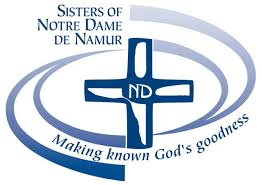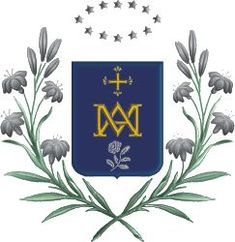
The Sisters of Notre Dame de Namur is a Catholic institute of religious sisters, founded to provide education to the poor.

Marguerite Bourgeoys, CND, was a French religious sister and founder of the Congregation of Notre Dame of Montreal in the colony of New France, now part of Québec, Canada.
A canoness is a member of a religious community of women, historically a stable community dedicated to the celebration of the Liturgy of the Hours in a particular church. The name corresponds to a canon, the male equivalent, and both roles share a common historical origin. As with the canons, there are two types: canonesses regular, who follow the Rule of St Augustine, and secular canonesses, who follow no monastic rule of life.

School Sisters of Notre Dame is a worldwide religious institute of Roman Catholic sisters founded in Bavaria in 1833 and devoted to primary, secondary, and post-secondary education. Their life in mission centers on prayer, community life and ministry. They serve as teachers, lawyers, accountants, nurses, administrators, therapists, social workers, pastoral ministers, social justice advocates and more.

Marie-Alphonse Ratisbonne, NDS was a French Jew who converted to Christianity and became a Jesuit priest and missionary. He later was a co-founder of the Congregation of Our Lady of Sion, a religious congregation dedicated to the conversion of Jews to the Christian faith.

The Marianites of Holy Cross (MSC) is a Catholic congregation of nuns, founded in Le Mans, France, in 1841, by Fr Basil Moreau. It was founded as a third distinct society within the Congregation of Holy Cross. The Marianites of Holy Cross is now an independent congregation.
A teaching order is a Catholic religious institute whose particular charism is education. Many orders and societies sponsor educational programs and institutions, and teaching orders participate in other charitable and spiritual activities; a teaching order is distinguished in that education is a primary mission.

Karolina Gerhardinger was a German Roman Catholic religious sister who founded the School Sisters of Notre Dame. Gerhardinger served as an educator in Bavaria until the establishment of her order, which provided free education to the poor and soon expanded in Europe.
The Society of the Sisters of Saint Ursula of the Blessed Virgin is a Roman Catholic religious congregation of women founded in 1606 at Döle, France, by the Venerable Anne de Xainctonge (1587-1612). Its members are especially involved in teaching.
The Third Order of Saint Francis is a third order in the Franciscan tradition of Christianity, founded by the medieval Italian Catholic friar Francis of Assisi.
The Congregation of Our Lady of Sion is composed of two religious congregations in the Roman Catholic Church founded in Paris, France. One is composed of priests and religious brothers, founded in 1852, and the other is composed of religious sisters, founded in 1843, both by Marie-Théodore Ratisbonne, along with his brother Marie-Alphonse Ratisbonne, "to witness in the Church and in the world that God continues to be faithful in his love for the Jewish people and to hasten the fulfillment of the promises concerning the Jews and the Gentiles"..

The Congrégation de Notre Dame (CND) is a religious community for women founded in 1658 in Ville Marie (Montreal), in the colony of New France, now part of Canada. It was established by Marguerite Bourgeoys, who was recruited in France to create a religious community in Ville Marie. She developed a congregation for women that was not cloistered; the sisters were allowed to live and work outside the convent. The congregation held an important role in the development of New France, as it supported women and girls in the colony and offered roles for them outside the home.
Our Lady of Sion School is an inter-denominational, independent school for male and female students, founded in 1862 and located in Worthing, West Sussex, on the south coast of England.

Jeanne de Lestonnac, ODN, also known as Joan of Lestonnac, was a French Catholic nun who founded the Sisters of the Company of Mary, Our Lady in 1607. The institute, approved by Pope Paul V in 1607, was the first religious order of women-teachers approved by the Catholic Church.

The Order of Our Lady of Charity is a Roman Catholic monastic order, founded in 1641 by Catholic saint, John Eudes in Caen, France.
Notre Dame School is an independent Catholic girls day school located in Cobham, Surrey, England. The school includes both a preparatory school and a senior school.

The Bernardine Cistercians of Esquermes are a small branch of the Cistercian Order. They follow the Rule of St Benedict, and co-operate with the apostolic mission of the Catholic Church through educational activities and hospitality. There are eight monasteries of nuns in six countries, united by a central Government.
The Congregation of Our Lady of Fidelity is a Catholic religious congregation of women founded in France in 1831 by Henriette Le Forestier d'Osseville, known in religion as Mother Saint Mary, which has as its primary goal the education of young women, especially orphans. They currently serve worldwide.

Alix Le Clerc, known as Mother Alix, was the founder of the Canonesses of Saint-Augustin of the Notre-Dame Congregation, a religious order founded to provide education to girls, especially those living in poverty. They opened Schools of Our Lady throughout Europe. Offshoots of this order brought its mission and spirit around the globe. Le Clerc was beatified by the Catholic Church in 1947.

Pudentiana Deacon was a Benedictine nun now known for her translation of Les vrais entretiens spirituels by Francis de Sales (1557–1662).













